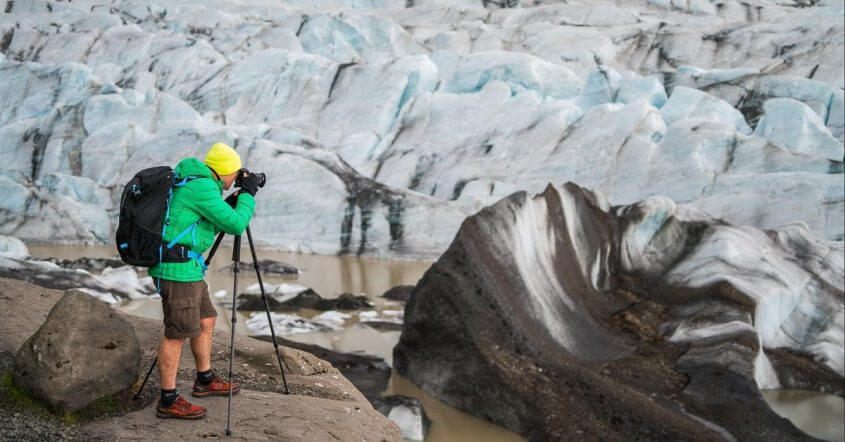2018 Light Pro Cameras for Hiking and Ultralight Backpacking
The Sony a7R III and a7R II are the perfect pro cameras for hiking and ultralight backpacking. They give you pro quality photos but without the weight. That is, this Sony camera gear is capable of the highest image quality but still light enough to be easily carried into the backcountry for a long day hike or a multi-day backpacking trip.
Lead photo above: Author working in Iceland with light Pro camera gear. Sony α7R II camera with Sony FE Carl Zeiss T* 24-70mm F4 ZA OSS lens on a Sirui T-024X Traveler Light Carbon Fiber Tripod. [Photo credit – Peyton Hale]
Why Take a Pro Camera Hiking?
If you want the maximum image quality but the least weight, your best option is a light full frame (FF), mirrorless camera like the Sony A7R II or A7R III. The following summarizes the ways a full frame camera is better than crop format (CF) camera like the Sony α6000 or α6500.
- A full frame (FF) camera like the Sony A7R II or A7R III can have up to 4x more resolution than a crop format (CF) camera like the Sony a6x000 series (37 pMP vs 8 pMp)
- A FF camera is more weight efficient for resolution. That is, you get more resolution (megapixels) per ounce than a CF camera.
- A FF camera also has more dynamic range (ability to capture a large range of lights and darks), color depth, and better low light performance.
Looking at the chart above you can see that 1) a full frame camera is capable of 4 times the resolution of a crop format camera, 37 pMP1 vs 8 pMP1 (left chart column cluster), and 2) that a full frame camera is more weight efficient, giving you almost 2x more megapixels of resolution per ounce of camera weight (right chart column cluster). 1 See more about pMP (perceptual megapixels)
What is a Full Frame Camera and How is it “Better”
Larger Full Frame sensor = better image quality: A full frame camera has a sensor* twice the size of a crop format camera (APS-C). And a larger sensor means better image quality. That is, the larger the sensor of a full frame camera gives more resolution (megapixels). But possibly more important, the larger sensor of a full frame cameras captures more light. And more light translates to better dynamic range (ability to capture a large range of lights and darks, many times critical for landscape photos), more color depth, and better low light performance/high ISO (also critical for photos in the “golden light” of dawn and dusk).
Better Lenses: Not a hard and fast rule, but the “better” lenses for full frame cameras tend to be superior to the best lenses for crop format cameras (but admittedly heavier and more expensive). E.g. the best Sony full frame wide angle zoom can resolve up to 35 pMP (on the 42 MP Sony α7R II) vs. the best Sony wide angle crop format zoom can resolve only 8 pMP (on the 24 MP Sony α6000). Taking into account sensor sizes, the full frame lens resolves 83% of the full frame sensor but the crop format lens only resolves 33% of its sensor’s capability.
- 860 mm² sensor area Full-Frame digital camera format, (36×24 mm)
- 370 mm² sensor area APS-C (crop format) standard format from Nikon, Sony… (23.6×15.7 mm)
* The sensor is the electronic hardware in a camera that captures light from the lens and converts it to an image/photo. Read more here.
A Caution – It’s not all about Megapixels
Just to put things in perspective: Getting good focus, correct exposure, eliminating camera shake (and of course, being in the right place at the right time!) are all more important than the megapixels of your camera. That is, you need to nail all of these to get the most of out a high-end camera. Blow any one of them and the resulting photo will likely be worse than one properly taken on a far less expensive camera or even a smartphone. [See more on how to get the best photos from your smartphone.]
Recommended – Light Pro Cameras for Hiking and Ultralight Backpacking
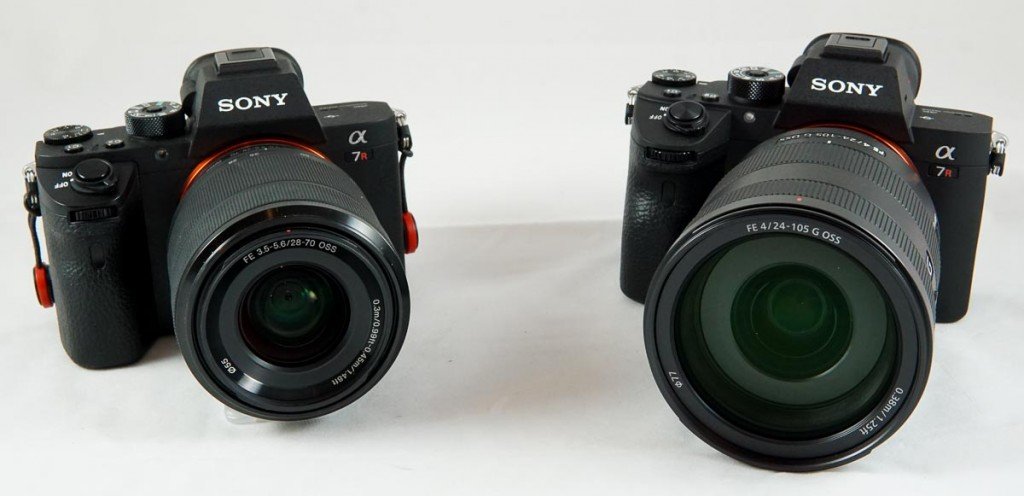
On the left is the Sony α7R II with the “general purpose” Sony 28-70mm F3.5-5.6 FE OSS Lens. It’s a light, economical, high resolution camera appropriate for almost all situations encountered hiking and backpacking. And it’s $1,800 and 13 oz less than the Sony α7R III with a FE 24-105mm f/4 G OSS Lens on the right. That being said, the α7R III with 24-105 has a significant advantage in image quality.
Standard Camera (on left above)
Sony α7R II 22.0 oz (625 g): This is the best value in a high quality FF mirrorless camera. It has the same 42 MP resolution as the newer and more expensive Sony α7R III. The Sony α7R II has nearly 14 stops of dynamic range (ability to capture a large range of light to dark without losing detail) and excellent autofocusing. When paired with the “general purpose” Sony 28-70mm F3.5-5.6 FE OSS Lens you have a light, economical, high resolution camera appropriate for almost all situations encountered hiking and backpacking. And it’s $1,800 and 13 oz less than the Sony α7R III with a FE 24-105mm f/4 G OSS Lens.
The Upgrade Camera (on right above)
Sony α7R III – 23.2oz (657g): This is the best light FF camera on the market! It outperforms the best from Nikon and Canon but weighs ¾ of a pound less! The Nikon D850 is 35.5oz (1005g) and the Canon EOS 5DS R is 35.6oz (1010g).
This camera has the same 42 MP resolution as its predecessor the α7R II, but improves upon it in many ways. Key features for hikers and backpackers are: 1) With 15 stops of dynamic range it bests the the α7R II by a full stop. 2) Battery life has doubled with the new Sony NP-FZ100 2280mAh battery. 3) Autofocus is more sophisticated, faster and more accurate. 4) Its 5-axis in-body image stabilization claims a full 5.5 stops.
Pair the Sony α7R III with the insanely sharp Sony FE 16-35mm f/2.8 GM Lens and you have a light, backcountry camera with image quality second to none. An added bonus, it’s so sharp that at 16mm and f/2.8, it can double as a good astro lens (making its weight and cost seem more reasonable). Or pair it with the new and moderately priced Sony FE 24-105mm f/4 G OSS, possibly the best midrange zoom lens in on the market
Note: All Sony gear was purchased with my own funds and this post reflects my own personal opinions. I am not a “Sony ambassador,” nor obligated to write content, or receive compensation from Sony.
Decide if Full Frame Image Quaintly Makes Sense for You
The increased image quality of Full frame is not cheap. That is, a full frame camera costs and weighs more than a crop format camera. Each hiker will need to decide if a potential 4x increase in megapixels (and other benefits like increased dynamic range, color depth, & low light performance) are worth it:
|
Recommended Lenses
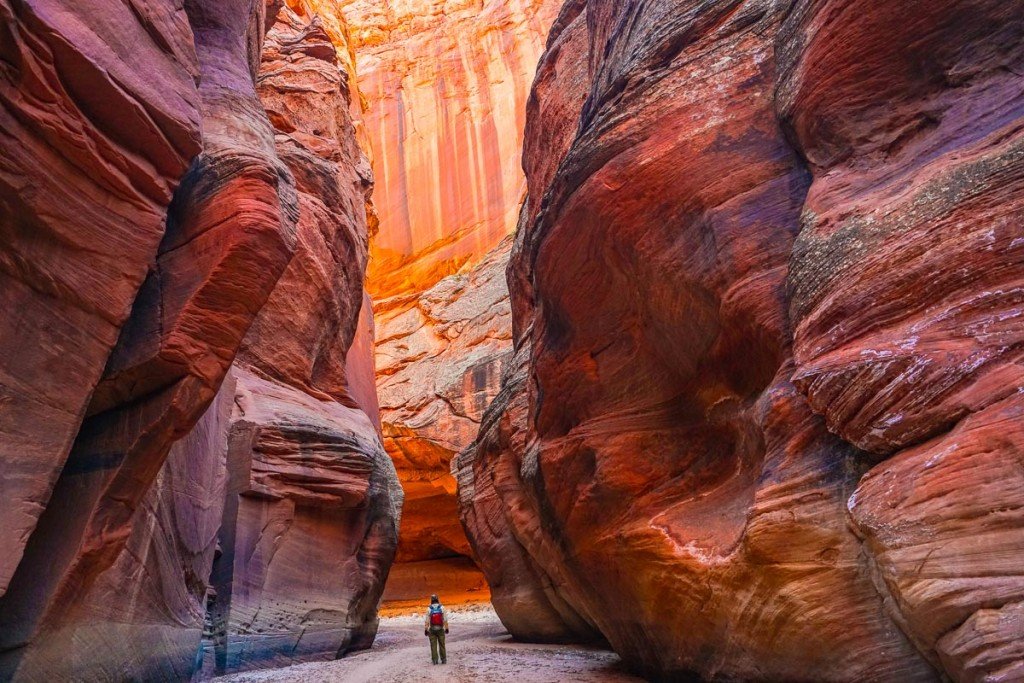
Buckskin Gulch Utah: Hand held with a Sony α7R II with Sony Vario-Tessar T* FE 16-35mm f/4 ZA OSS lens.
The following lenses were carefully selected to provide an optimal balance of sharpness, low weight, and reasonable cost (for a full frame lens). An effort was made to provide a few price and weight options for each lens type.
General Purpose (midrange) Zoom Lenses
If you are bringing only one lens, a General Purpose (midrange) Zoom is likely the one you want. These are workhorse lenses going from a decent wide angle to a moderate zoom. They come in two flavors, ~24mm-70mm and ~24-105mm. The 24-70s are lighter and more compact. But the 24-105 range is especially useful. 24mm is plenty wide enough for most landscape work. And 105mm is good for picking out landscape details. And in a pinch, at 105mm it works as a wildlife zoom since with 42 MP you can crop down to the sharp center area of the lens and still have a serviceable photo. (another advantage of FF)
Bargain Lens
♦Sony 28-70mm F3.5-5.6 FE OSS Lens 10.4 oz: This “starter” lens for the Sony FF (FE) cameras is a great value and a perfect fit for hikers and ultralight backpackers. It far exceeds expectations, and the international version can be had for $285! This lens is very light and nearly as sharp as the next lens “up,” the far more expensive and heavier 24-70mm F4 ZA OSS. The 28-70 F3.5-5.6 is weather resistant while the 24-70mm F4 is not. The 28-70 gives up some edge sharpness at wider apertures vs. the 24-70mm F4. And its narrower 28mm vs. 24mm makes more of a difference for landscape work than the “slight” 4mm difference might infer. Nonetheless, you are unlikely to find a better low cost full frame lens suited to rugged backcountry use*.
*Its light weight and low cost make this a great lens to take into harsh environments with higher risk of damage, theft, etc. The lens is the most likely thing to be damaged. And if that happens, you are only out a few hundred vs. a few thousand dollars. E.g. this is the lens I took to remote mountain regions in Cuba, and the one I would take for a long trip to the desert with all its fine windblown sand.
Upgrade Lenses
♦Sony FE 24-105mm f/4 G OSS 23.4 oz: This new and exciting lens is likely the the best midrange zoom lens on the market. It’s only been out for a few months but my initial impressions (and those of many others) is that it’s extremely sharp edge to edge–coming close to the performance of far more expensive lenses. It’s about 1/2 the price of most of the competition but it’s smaller, lighter, image stabilized and weather resistant. In summary, a great pro-quality lens at a bargain price [In fact, it takes much of the market away from the heavier and more costly Sony 24-70 f/2.8 and Sony 24-70 f/4].
Sony FE Carl Zeiss Vario-Tessar T* 24-70mm F4 ZA OSS 15 oz: Prior to the 24-105mm f/4 G OSS, this would have been the light general purpose zoom of choice. It is sharper edge to edge vs. the less expensive 28-70mm F3.5-5.6 OSS. And even now, if you need a lens in this focal range for under 16 oz, choose this one (the 24-105mm f/4 G OSS is a full 10 oz heavier).
Wide Angle Zooms
A wide angle zoom in the range of 16mm-35mm is on my camera most of the time (I use this focal range for over 2/3 of my backcountry photos). The 16 to 24 mm range is especially useful for capturing broad swaths of landscape or creating stunning perspectives that give snap to your photos.
Standard Lens (no budget lenses here)
Sony Vario-Tessar T* FE 16-35mm f/4 ZA OSS 18.3 oz: If you need a small and light wide angle zoom this is it. The lens is sharper in the corners than the 28-70 f/3.5-5.6, image stabilized, and it doesn’t cost an arm and a leg. But it’s not as sharp as the new, non-image stabilized 16-35mm f/2.8 GM (below). Even so, I’ve carried this lens on many, many trips. And I will continue to take it when weight is critical.
Upgrade Lens
Sony FE 16-35mm f/2.8 GM Lens 24 oz: This Sony G-Master lens one of the best wide angle zooms on the market. It’s so sharp edge to edge that its sharper than most prime lenses in its focal range. It’s ¼ pound lighter than Canon’s 16-35 f/2.8 lens (and some, but not all, reviewers have tested it sharper than the Canon). And Nikon has nothing that can touch it. An added bonus, it’s sharp enough at 16mm and f/2.8 that it can double as a decent astro lens (and make its weight seem more reasonable). Its major downside is cost — but you get what you pay for.
Prime (fixed focal length) Lenses
These lenses are lighter and usually sharper than zoom lenses. Price varies over a wide range from inexpensive to quite expensive.
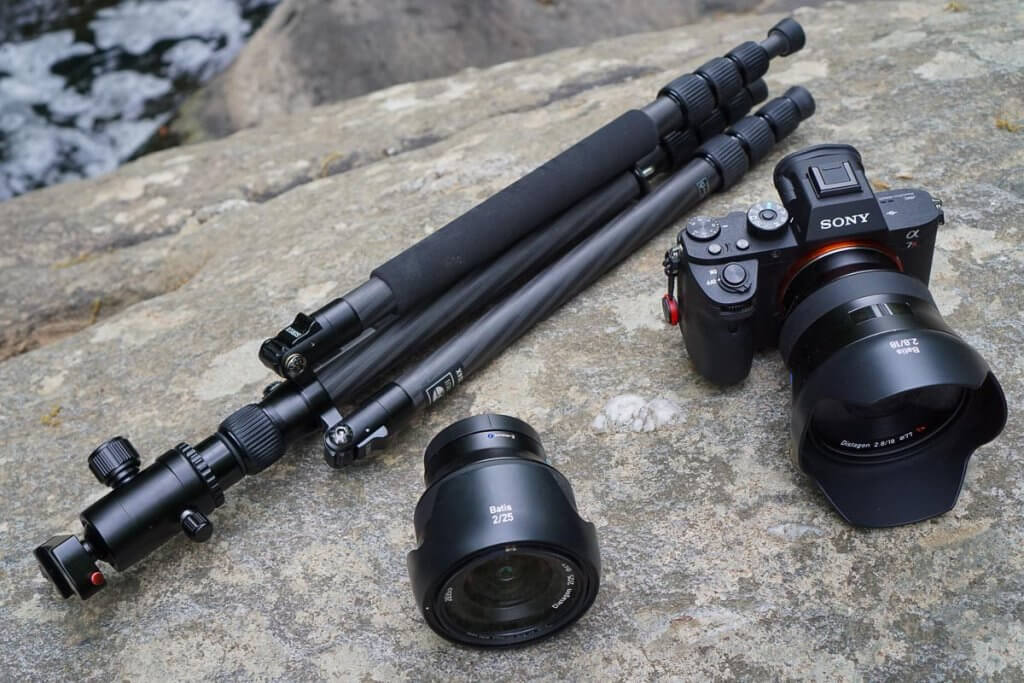
Two light, fast and exceptionally sharp prime lenses: (r) one of my favorite lenses the ZEISS Batis 18mm f/2.8 Sony FE, 11.64 oz; (l) Carl Zeiss Batis 25mm F2 Sony FE 11.82 oz. In the backgroud is the Sirui T-024X Traveler Light Carbon Fiber Tripod with C-10S Ball Head, a light, economical and capable backcountry tripod.
Normal Prime Lenses
♦ Sony FE 50mm F2.8 MACRO 8.3 (236 g): This is the VALUE winner in Sony’s FE lens lineup. Almost as sharp as 55mm f/1.8 below but 1/2 the cost, and 1.5 ounces lighter, and dust and moisture resistant. Oh, and it goes 1:1 for macro photography.
Sony Sonnar T* FE 55mm f/1.8 ZA 9.9 (281 g): The lightweight star of Sony’s FE lens lineup. The 55 f/1.8 FE is light, small and insane sharp (resolving to 40 pMP!). Perfect for shooting handheld in low light situations. Not really cheap, but likely still a bargain given its performance.
Wide Angle Prime Lenses
These are mostly listed in order of focal length. And I have tried to keep cost down (within reason) on most of these selections.
♦ Rokinon 14mm f/2.8 ED AS IF UMC Lens for Sony E-Mount 20.11 oz (570 g) – A great value for an excellent and sharp astro (and landscape lens). Downside is that it is fully manual. But then that’s desirable for astro photography and just fine when you are shooting landscapes off a tripod.
Laowa 12mm f/2.8 1.34 lb (609 g) – Amazingly wide and sharp. It has zero distortion which is nothing short of magic for a lens this wide. Great mechanical build. It also makes a decent astro lens. Downside is that everything is manual, so it’s not as handheld friendly as lenses that electronically couple with your camera. Oh, and it’s not light!
ZEISS Batis 18mm f/2.8 Sony FE 11.64 oz (330 g) – A personal favorite. Super sharp, light and compact. A standout landscape and astro lens. A “native” Sony FE lens, it couples electronically with the camera. Only downside is cost.
♦ Sony FE 28mm F2 – Inexpensive, fast, light and crazy sharp. A solid focal length for many landscape shots. And if you can live with 28mm, it makes a good astro lens. It’s also a fantastic deal. (not quite as sharp at f/2 as the more expensive competition)
Carl Zeiss Batis 25mm F2 Sony FE 11.82 oz (335 g) – A bread n’ butter landscape lens. Light and fast with outstanding sharpness edge to edge — even wide open. Only downside is cost.
♦ Sony FE Carl Zeiss Sonnar T* 35mm F2.8 ZA 4.2 oz 120 – Crazy light and small for a great utility wide angle lens. Moderate cost given its high performance and dust and moisture resistance.
Telephotos Lenses
I rarely use these on backpacking trips where carrying a bulky and heavy lens for days seems like a bad idea. Even light telephotos lenses are heavy, expensive and infrequently used (unless your goal is photographing wildlife or climbers, etc.). As mentioned earlier if I need a long lens on backcountry trip, I make due with cropping an image from the 24-105mm f/4 G OSS.
Tripods
My choice for a backcountry tripod is the light and low cost Sirui T-024X Traveler Light Carbon Fiber Tripod with C-10S Ball Head. In many (but not all) situations it will work for a Sony α7R II camera with a lighter lens like the Sony 28-70mm F3.5-5.6 FE OSS Lens or 16/35 f/4. It will hold the camera quite stable (using a remote shutter or 2 sec delay) given the wind is not too strong or tripod legs aren’t a few feet deep in rushing water. (And you can hang weight off the center column if you need more stability.) That being said, for heavier lenses like a 70-200 zoom or the 16-35 f/2.8, while the legs are fine, you’ll likely need to use a larger ball head.
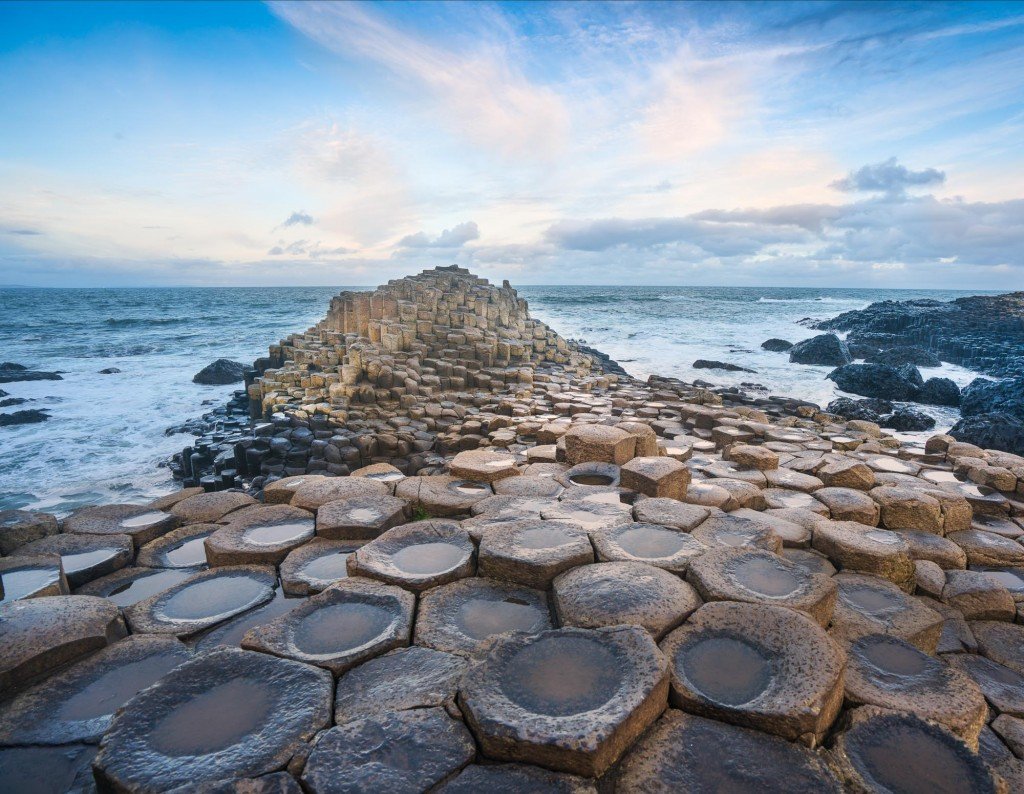
Dawn at the Giant’s Causeway on the Northern Coast of Ireland: Sony α7R II with Sony Vario-Tessar T* FE 16-35mm f/4 ZA OSS lens on a Sirui T-024X Traveler Light Carbon Fiber Tripod.
Why Not Canon or Nikon Full Frame Cameras?
Canon and Nikon owners will likely wonder why their cameras and lenses aren’t in this post. The quick answer is that their full format gear is heavier (mostly due to not being mirrorless like the Sony). So for the same image resolution (pMP) you are likely carrying approximately 1 to 2 pounds more weight for a Canon or Nikon camera/lens combination vs. the Sony camera/lens combination.
From the chart above you can see that mirrorless Sony a7R III (blue) is lighter (has more resolution per ounce of camera+lens weight) than Canon or Nikon full frame cameras. For the comparison I used three basic lens types common for backcountry use (below)—picking the most appropriate/similar camera and lens combination for each manufacturer. For all types of lenses listed, the Sony system is significantly lighter than Canon or Nikon.
- Utility Zoom = moderate cost ~24-70mm zoom. e.g. Sony 28-70mm F3.5-5.6 FE OSS Lens
- High-end Landscape Zoom = 16-35 quality zoom, e.g. Sony FE 16-35mm f/2.8 GM Lens
- Prime Wide Angle = a light 24 to 28mm lens f/2 or better, e.g. Sony FE 28mm F2
And just to be clear, both Nikon and Canon make great full frame cameras and lenses. Many professionals for years have been getting stunning photos in extreme locations with these cameras (e.g. Jimmy Chin, a personal hero of mine). But in the end, Nikon and Canon cameras are heaver than their Sony counterparts for similar resolution and image quality. To some that may not matter all that much. Finally, the camera and lens are only part of what makes a great picture. So to beat a dead horse, the photographer, good technique and above all being in the right place at the right time matter far more.
Footnotes
1 pMP (perceptual megapixels): Sharp as I use it in this post is the “perceptual megapixels” of the final image. This is a combination of both lens and camera—not simply the native resolution of the camera sensor! Thus a 45 MP camera, with an OK-but-not-great lens might only achieve a final photo with an resolution of 20 MP. That is, the pMP of the camera/lens combo is 20 pMP. Read more here on “What is sharp?”
Disclaimer
This post contains affilate links. If you make a purchase after clicking on the these links, a portion of the sale helps support this site at no additional cost to you. I do not receive compensation from the companies whose products are listed. For product reviews: unless otherwise noted, products are purchased with my own funds. I am never under an obligation to write a review about any product. Finally, this post expresses my own independent opinion.

